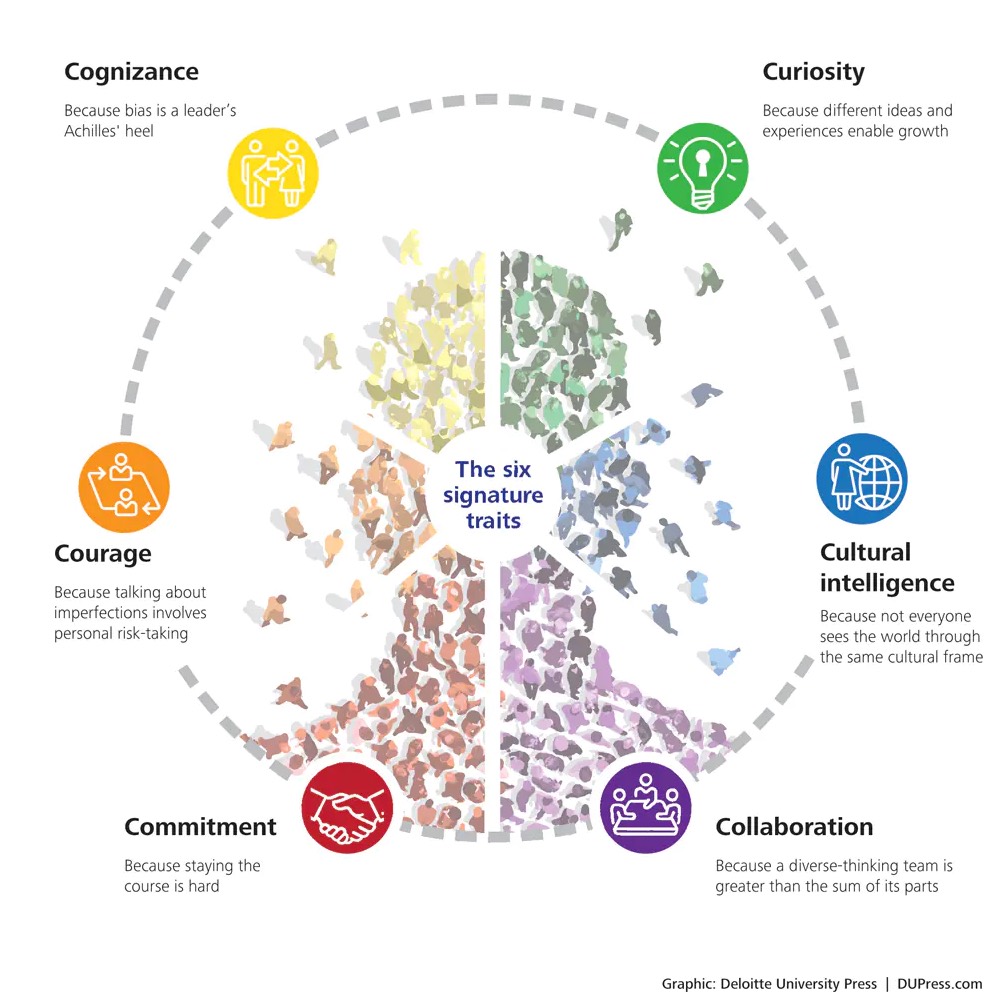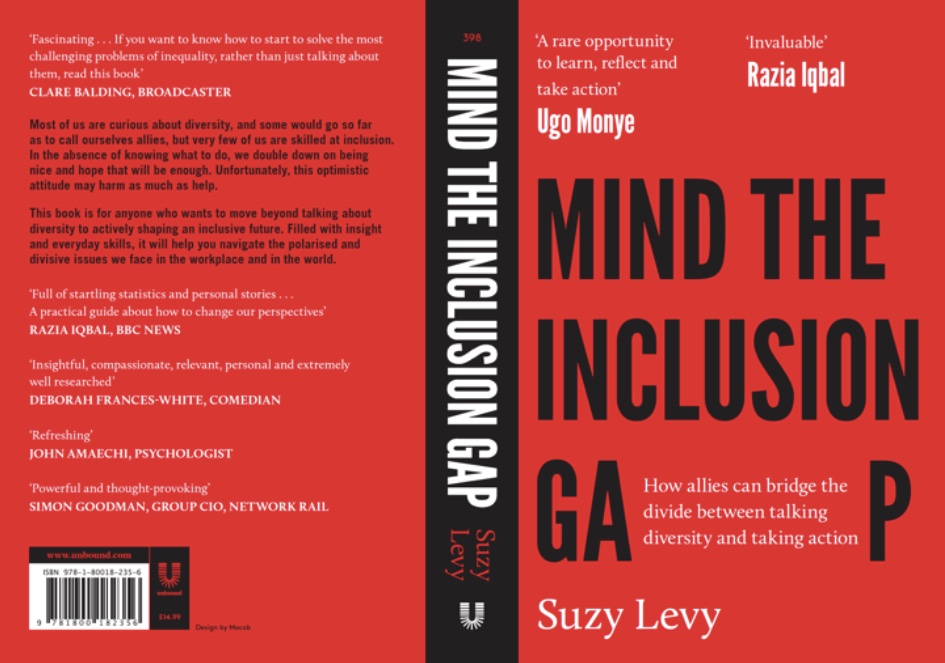Inclusive leadership is a critical capability helping organizations adapt to diverse customers, markets, ideas and talent. For those working around a leader, such as a manager, direct report or peer, the single most important trait generating a sense of inclusiveness is a leader’s visible awareness of bias. But to fully capitalize on their cognizance of bias, leaders also must express humility and empathy.
A study of inclusive leaders from Australia, New Zealand, Singapore, Hong Kong, Canada, and the U.S., conducted by Deloitte Australia, shows that inclusive leaders tend to share six signature traits that promote diversity on their teams and improve their capacity to innovate and deal with uncertainty.

Commitment– Cultivating a diverse, inclusive workforce takes time and energy. So, what motivates some executives to champion this issue? In addition to a belief in the business case, inclusive leaders are driven by their values, including a deep-seated sense of fairness that, for some, is rooted in personal experience. Inclusive leaders believe creating a welcoming culture begins with them, and they possess a strong sense of personal responsibility for change. When executives devote time, energy, and resources to nurturing inclusive workforces—by investing in people and inspiring others to share their passion and goals—their actions signal a true commitment.
Courage– Inclusive leaders demonstrate courage in two ways. First, they aren’t afraid to challenge entrenched organizational attitudes and practices that yield homogeneity, even if their recommendations are politically or culturally unpopular. Nor are they afraid to display humility by acknowledging their personal limitations and seeking contributions from others to overcome them. Some leaders find it difficult to admit they don’t have all the answers; in that respect, courage and humility go hand in hand.
Cognizance of bias- Inclusive leaders understand that personal and organizational biases narrow their field of vision and preclude them from making objective decisions. They exert considerable effort to identify their own biases and learn ways to prevent them from influencing talent decisions. They also seek to implement policies, processes, and structures to prevent organizational biases from stifling diversity and inclusion. Without such measures, inclusive leaders understand that their natural inclination could lead them toward self-cloning, and that operating in today’s business environment requires a different approach.
Curiosity- Open-mindedness, a passion for learning, and a desire for exposure to different ideas have fast become leadership traits crucial to success, especially in challenging times. Curiosity and openness are hallmarks of inclusive leaders, who hunger for other perspectives to minimize their blind spots and improve their decision-making. In addition to accessing a more diverse array of viewpoints, inclusive leaders’ ability to engage in respectful questioning, actively listen to others, and synthesize a range of ideas makes the people around them feel valued, respected, and represented. Inclusive leaders also refrain from making fast judgments, knowing snap decisions can stifle the flow of ideas on their teams and are frequently tinged with bias.
Cultural intelligence– Knowledge of other cultures is essential for CIOs whose work takes them, for example, to offshore development and operations centres. Beyond “book” knowledge, cultural intelligence connotes leaders’ ability to change their styles in response to different cultural norms. For example, culturally intelligent leaders who are typically extroverted and demonstrative will make an effort to show restraint when doing business with individuals whose cultures value modesty or humility. They regulate the speed and tone of their speech and modify their nonverbal behaviours—gestures, facial expressions, body language, and physical interactions—as situations dictate. In addition to understanding other cultures, these leaders also demonstrate self-awareness of their own culture, recognizing how it shapes their worldview and how cultural stereotypes can influence their expectations of others.
Collaborative- Inclusive leaders understand that, for collaboration to be successful, team members must first be willing to share their perspectives. To that end, they create an environment in which all individuals feel empowered to express their opinions freely with the group. They also realize that diversity of thinking is critical to effective collaboration; thus, they pay close attention to team composition and team processes. For example, they prevent teams from breaking into subgroups, which can weaken relationships and create conflict. They also engender a sense of “one team” by creating a group identity and shared goals, and by working to ensure team members understand and value each other’s knowledge and capabilities.
Suzy Levy, Author of Mind the Inclusion Gap, takes up the story…
As leaders, we play a key role in how opportunity is dished out. That opportunity is delivered in formal moments when we decide who gets hired, who gets promoted, or who gets chosen for leadership development programmes. It also gets handed out in more informal moments where we make a quick call about who we deputise to when we go on holiday, who gets the stretch assignment that will go hand-in-hand with visibility, or how we approach coaching when one of our team members makes a mistake.
It took me a long time to understand that systemic ‘isms (racism, sexism, homophobia, etc) don’t live in nasty comments or rude words. They thrive when the affinity you have for someone is just a little bit less. When you are a little bit less likely to positively coach the person who made a mistake with words like ‘you got this’ and ‘let’s make sure we work on changing this together’. Instead, we say things like ‘show me how you’re going to make sure this won’t happen again’ and ‘how do you think you could have handled this better’, or we when we don’t say anything at all. We pass over that chance to make this a growing moment and move on to the next person who won’t let us down.
At an individual level, these little dips in affinity don’t matter much. But unfortunately, when we don’t know a group or individual very well, the layering affect when many leaders (who are often white, and often men) feel slightly less positive is huge.
Mind the Inclusion Gap, is available at all good bookstores including Blackwells, WH Smith and Waterstones.

Get in touch to discover how we could help you develop more conscious leadership in your organization.


